Article adopted from a post in Marshall’s Musings, the author’s personal blog
In central Toronto, bike lanes and cycle tracks are the predominant form of cycling infrastructure. While there are some bike lanes in suburban Toronto and in other municipalities like Mississauga and Brampton, most bike routes, if they exist, are off-road multi-use trails, in ravine or hydro corridors, or alongside major roads, like sidewalks.
Multi-use paths are pleasant to ride on, but they’re often treated as recreational trails, rather than transportation corridors. Most paths are not cleared of snow in the winter, and they are often isolated from the adjacent road network and local destinations, and they can meander, rather than follow straight lines. Road crossings can often be awkward.
Bike lanes, which offer less protection from motorized traffic at least are integrated with the rest of the street grid, and are generally more direct. But on fast-moving suburban arterial roads, they aren’t ideal without separation. This is where the side-of-road path comes in.
In Mississauga and Brampton, there are many new side-of-road shared pathways, which follow major traffic arterials such as Derry Road and Bovaird Drive. These shared paths are similar to sidewalks, but are paved with asphalt instead of laid concrete, are wider, easy and inexpensive to install, and don’t take space away from automobiles and trucks. But they have their drawbacks.
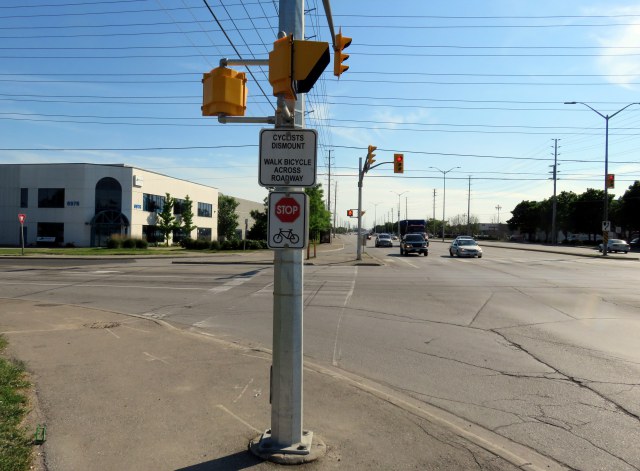
Sign instructing cyclists to dismount and walk bicycle across road crossing on Derry Road in Mississauga
At every intersection (and even some at private driveway crossings), there are signs instructing cyclists to stop, dismount, and walk their bikes across. Suburban intersections are built to move cars and trucks quickly, often featuring wide turning radii and channelized right turns. There are no dedicated traffic signals for cyclists; they are expected to cross like pedestrians, on foot, often across nine lanes of traffic at a time. The alternative is riding with traffic, or not riding at all.
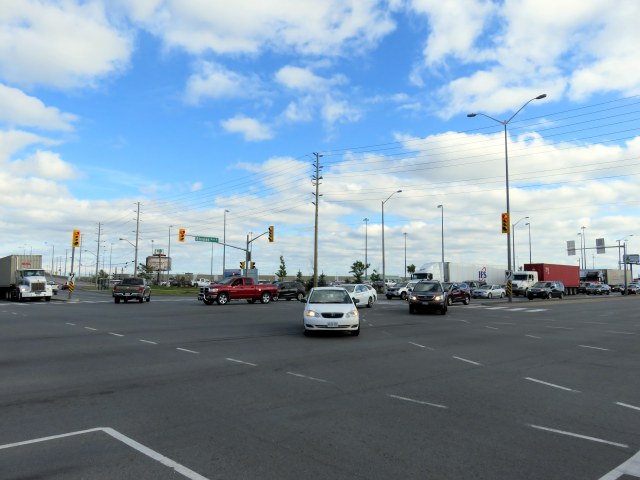
Steeles Avenue and Bramalea Road, Brampton. On the other side of this intersection is a major GO Transit rail and bus hub.
The City of Brampton has a great pathway master plan, developed in 2002, but the recommended network has yet to be realized. Many off-road trails, through ravines and utility corridors do not feature curb cuts — cyclists must jump the curb, ride on the sidewalk, or dismount and remount at each curb. In Brampton, off-road paths are designated as “recreational trails,” which is indicative of persistent attitudes of cycling being a recreational activity, rather than a legitimate mode of transportation.
At least Toronto can show the way. On Eglinton between Scarlett Road and The West Mall in Etobicoke, the City of Toronto maintains a cycling path along the wide boulevard on the south side of Eglinton. At some intersections there are separate crosswalks and cross-rides that reduce the likelihood of conflicts between cyclists and pedestrians. Intersections are clearly marked, and newer installations include bicycle signals.
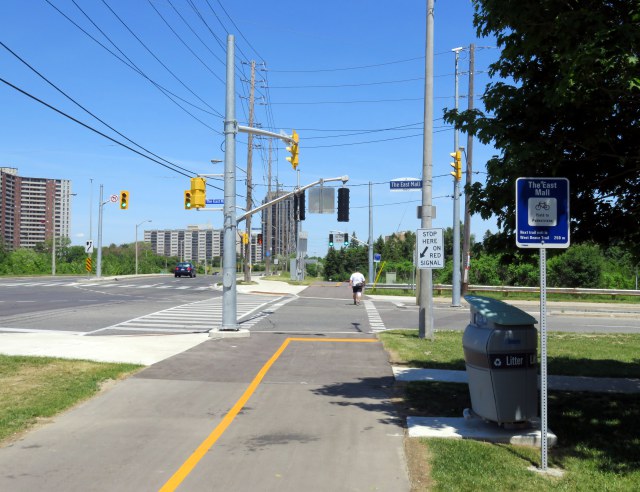
Sidepaths are a very useful and simple way to improve cycling infrastructure in suburban locales, where wide right-of-ways provide space for cyclists and pedestrians to share wide paved pathways on the side of busy roads. But intersections need to be improved, forcing drivers to slow down when making right turns and watching for vulnerable road users. But it can be done. After all, there are plenty of cyclists already in Toronto’s suburbs, and they have as much of a right to safe routes as downtowners.

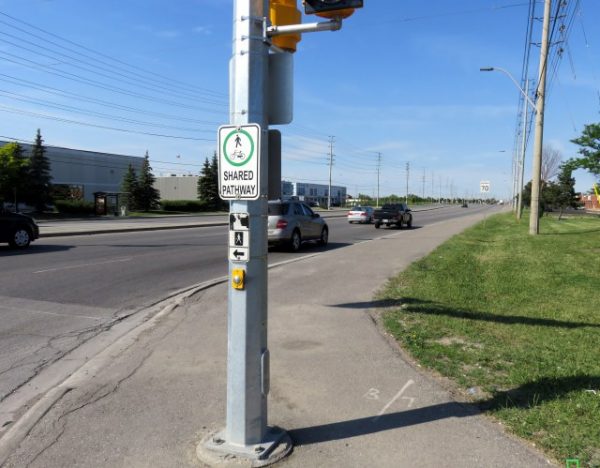


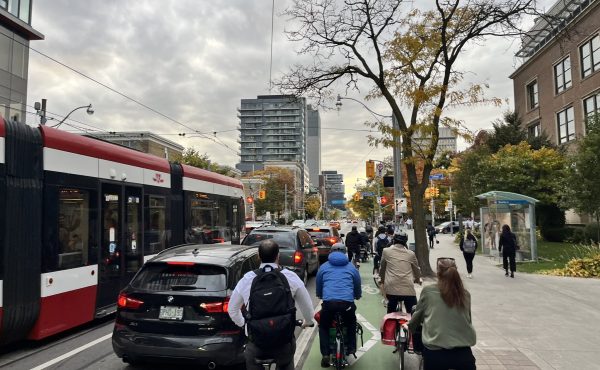
5 comments
At intersections, the signs instructing cyclists to stop, dismount, and walk their bikes across will ALWAYS be ignored. They’re put up by non-cyclists.
The reason dismount signs are put up at intersections with side paths is that cars are not expecting quick moving cyclists to cross the road from the sidewalk position. It is for that reason that it is more dangerous for cyclists to ride on the sidewalk, unless one walks across intersections.
As an all year utilitarian cyclist I’ve learned to avoid streets with side paths when possible, as I generally don’t want to ride with recreational users (Lakeshore, Eglinton) on winding paths with awkward road crossings. When paths are available, no matter how snow-covered, or full of dog walkers they are, cars & trucks expect us to stay on them. Those that dare to ride on the road get honked at or told to get on the sidewalk.
Given the problems with intersections, roads like Lakeshore where the Gardiner was removed, and Eglinton W in Etobicoke, discourage the addition of crossings and do not allow new businesses to have pedestrian entrances onto the multi-use paths as they would if a sidewalk were present. This ensures that they will always remain auto oriented highway buffers. This may be why side paths have been pushed by transportation planners ever since Sam Katz implemented the side path on Eglinton Ave W as part of a planned city wide network.
In the suburbs, bike lanes generally mean trails in part because most people still relate to cycling in terms of recreational usage, rather than people who are trying to get somewhere.
I support on-street bike lanes like Richmond/ Adelaide (when construction allows) which provide protection, are not for dog walkers, allow for normal intersections, direct routes, lighting & maintenance, and do not sterilize the corridor for pedestrian oriented development. It’s all in the details, and I support any side paths that can accomplish this.
And once again the car is sacrosanct. When will we ever move beyond this?
@W. K. Lis
Ignored if they want a fine. You can’t ride a bike through a pedestrian crossing as per the HTA.
It’s bizarre that even when suburban transportation planners create dedicated infrastructure for cyclists, they still treat them as second class citizens. They should go for a 15 kilometre ride twice a week for a month, dismounting and walking across every intersection along the way, using the infrastructure they designed as they designed it. Perhaps then they’d design something more practical for the road users they’re trying to help (cyclists). But more likely they’ll just stop cycling after the month.